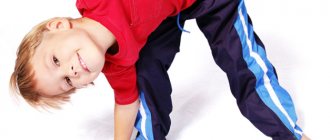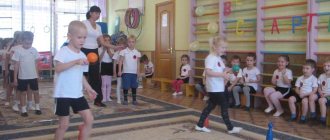Non-traditional forms of morning exercises in preschool educational institutions.
"Non-traditional forms of holding
morning exercises at preschool educational institutions"
The preschool period is the time when the foundation of physical, mental and moral health is laid. Among the many factors that influence the health and development of children, physical education occupies a special place in terms of intensity. In introducing children to a healthy lifestyle, their mastery of the basics of hygienic and physical education is of particular importance. The task of physical education of preschoolers is to form in them a stable habit of systematic physical exercise. Morning exercises play an important role in solving this problem. Although morning exercises in preschool educational institutions are short in time, they compensate for up to 5% of the daily volume of physical activity of children and are considered as an important element of the motor regime. Doing a set of morning exercises every day is the minimum physical activity that should become an element of every child’s personal physical culture. The special place of morning exercises in the daily routine is due to the important role that the transition from sleep to wakefulness, from rest to active activity plays in a person’s daily biological rhythm.
Analysis of previous work, the results of surveys and observations led to the conclusion that it is necessary to model morning exercises of a new type. Currently, many new methods of performing gymnastics have appeared. In order to increase children's interest in exercise, kindergarten teachers introduced non-traditional forms of morning exercises, such as:
— game stretching;
— step aerobics;
- gymnastics on fitballs.
Game stretching (application No. 3)
Game stretching
– these are specially selected muscle stretching exercises performed with children in a playful way. In other words, this is a creative activity in which children live in a world of images, often no less real to them than the surrounding reality.
The implementation of gaming opportunities for the health and development of the child is the essence of gaming stretching. Moreover, all classes are conducted in the form of a role-playing or thematic game, consisting of interrelated situations, tasks and exercises.
The method of play stretching is based on static stretching of the muscles of the body and the joint-ligamentous apparatus of the arms, legs, and spine, which allows one to prevent and correct postural disorders and have a profound healing effect on the entire body.
Exercises are performed without outside influence, because The human body is its own trainer. Self-manipulation of the body in a slow, and therefore safe, rhythm is most effective. In children, complexes associated with the physical imperfection of the body and the inability to control it disappear. In addition, children acquire a reserve of motor skills that allow them to feel strong, beautiful, self-confident, and create a sense of inner freedom.
Features of the morning exercise complex for the preparatory group
Physical education classes for children aged 6-7 years differ significantly from those conducted in younger groups. They last longer. They include practicing a variety of exercises that develop coordination of movements, speed of reaction, endurance, and also cultivate team spirit. In the senior group, children are introduced to the skills and abilities necessary to study physical education in the primary school curriculum. Despite this, to achieve your goals, it makes sense to conduct classes in a fun, playful way.
Various methods and techniques are used for this:
- Performing a traditional set of exercises, which consists of walking, turning, squatting, jumping, bending, etc. During such exercises, muscles are trained, and the ability to hear and follow the teacher’s speech commands is developed.
- Rhythmic gymnastics classes, when children perform dance movements to music, achieving the required load with the number of repetitions and an accelerated tempo of performance. Music lifts your spirits and helps develop your sense of rhythm and ear for music.
- Exercise and warm-up will be fun and interesting using an obstacle course or a “health track”. In this case, children are asked to overcome specially prepared areas barefoot that are devoid of their usual smoothness. Walking on uneven, rough surfaces is an excellent prevention of flat feet.
- Warm-up games also help to memorize repetitive movements, increase motor activity and provide a positive emotional charge for the whole day.
Outdoor games
Complex of morning exercises in the preparatory group for a year according to the Federal State Educational Standard
Morning exercises are an important part of the educational plan aimed at the full and comprehensive development of preschool children. The physical education program is designed in such a way that the physical development of a child aged 6-7 years corresponds to the Federal State General Education Standards (FSES). To draw up a high-quality plan for this subject, educators and preschool workers can use collections containing a card index of exercises designed for classes throughout the year.
Note! Priority is given to manuals approved and recommended for use by the Ministry of Education and issued in accordance with the Federal State Educational Standard. An example of such a publication can be considered the book “Health Gymnastics. Sets of exercises for children 3-7 years old. Federal State Educational Standard. Penzulaeva L.I.”
Time plan
Morning exercises are carried out throughout the year. Depending on the month and climatic features of the area, the lesson can be held in the gym or on the street.
Complex of morning exercises for the middle group
Important! The teacher needs to see all the children performing the movement. In this case, he will be able to control the technique of performing the exercise, notice and correct the mistake in time, and thereby give the child the opportunity to get the maximum benefit from the lesson.
Regardless of the teaching method and location chosen by the teacher, the lesson should always consist of three parts:
- Warm-up serves as an organizational moment, preparing the child for a more intense pace of exercise. Walking, turning, and various swings help warm up the muscles and prepare the body for the next more active physical activity.
- The main part should influence the strengthening of the muscles responsible for posture. To achieve the effect, exercises for the cervical region, arms, legs, and abs are done from different starting positions. This part uses jumping and running, which have a positive effect on strengthening the arches of the feet. For better results, sports equipment is used: jump ropes, gymnastic hoops and sticks. It makes sense to think in advance about how sports equipment and other auxiliary items will be distributed and collected. This moment should not create unnecessary fuss and distract the children from the general rhythm of the lesson.
- The final part includes slow movements aimed at normalizing breathing and heart rate.
Gymnastic apparatus
Duration of morning exercises in the preparatory group
Charging time depends on the age of the children. In the preparatory group it is 10-12 minutes. Of this time, the main part takes 6-8 minutes.
Important! The teacher must not only explain the principle of performing the required set of exercises, but also monitor the technique and breathing during their execution. Therefore, it is important that the adult conducting the exercises first studies all the exercises, imagines their complexity and the real capabilities of the children. This will allow you to accurately determine the number of repetitions and approaches.
Complex of morning exercises in the middle group “Snake and I are good friends!”
Complex of morning exercises using non-traditional equipment
“Snake and I are good friends!”
Fomina Victoria Vladimirovna
teacher
Name of the morning exercise complex:
“Snake and I are good friends!”
Age group:
middle group
Petrozavodsk urban district.
2017
A complex of morning exercises for the middle group.
“Snake and I are good friends!”
Equipment:
“hemp” (circles made of thick cardboard), “snakes” (green caps collected on a thread), tape recorder, recording the sound of a snake hissing, a cheerful musical composition.
Motivation of children:
- audio recording of snake hissing
- funny poem
- interesting non-traditional manual (“snakes”, “hemps”)
- the names of the exercises cover one topic
- low mobility game “A snake walked across the field”
- cheerful musical accompaniment
Introductory part:
Between the green grass,
Between old stumps, leaves and mushrooms,
Crawled, hissing into the bushes
The snake is a long string.
Walking in a column. Easy running. Walking like a snake, going around the “stumps”.
Children go around the “stumps”, at this time
The teacher turns on the sounds of a snake hissing and asks: “Who is that hissing?” (Children answer “snake”)
Main part:
- “Hello, snake!”
. I. p. - feet shoulder-width apart, hands folded behind the back. Take a breath. Lean forward. Exhale. Return to starting position. (1 - 2 times)
- “Pick up the snake.”
I. p. - stand with legs apart, “snake” at the bottom. 1 — lift the “snake” forward; 2 - up; 3 - forward; 4 - return to the starting position (5-6 times).
- “Put the snake down.”
I. p.: feet shoulder-width apart, “snake” below. Lean forward, lowering the “snake”, return to the starting position (5-6 times).
- “Show me the snake.”
I. p. - stand with feet shoulder-width apart, “snake” at the bottom. 1 — lift the “snake” forward; 2 - sit down, arms straight; 3 - stand up, “snake” forward; 4 - return to the starting position (5-6 times).
- "Jump over the snake."
I. p. - stand with legs slightly apart, arms at random, “snake” on the floor. Jumping on two legs over a snake. (5-6 times)
- Low mobility game “A snake walked across the field”
The “snake” walks in front of the players with the words: “The snake walked across the field and dropped its tail, (approaches one
of the players)
and then found it”
(touches the child’s “tail”).
The player must crawl between the legs of the “snake” and become its “tail”. And so on until all the children of the “tails” are collected.
Children take "snakes"
stand in a circle.
The “snakes” are placed on the stumps.
According to the counting rhyme, the driver is selected as a “snake”, and the rest of the guys are “tails” of the snake.
Final part:
Goodbye, snake! Crawl away quickly!
Your children are waiting for you
That's a loud name!
All the children, linked to each other (a long snake), walk around the hall. A short walk.
Breathing exercise
“We hiss like snakes”
Children say “sh – sh – sh – sh...”
The teacher turns on cheerful music.
Bibliography:
- FROM BIRTH TO SCHOOL. Basic educational program of preschool education / Ed. N.E, Veraksy, T.S. Komarova, M.A. Vasilyeva. – M.: MOSAIC-SYNTHESIS,
2015. - 368 p.
Photos of visual aids that were used during morning exercises.





